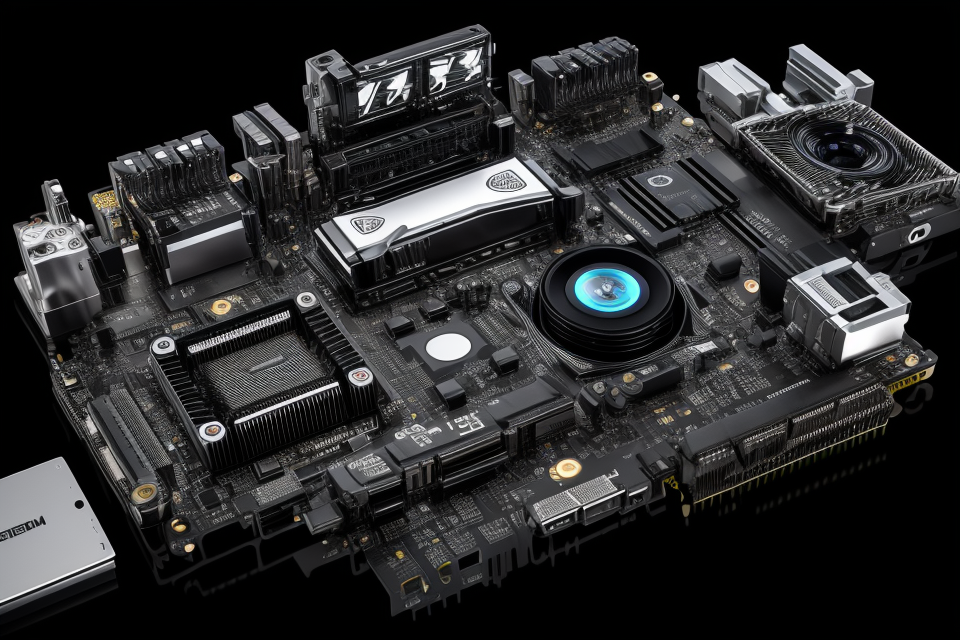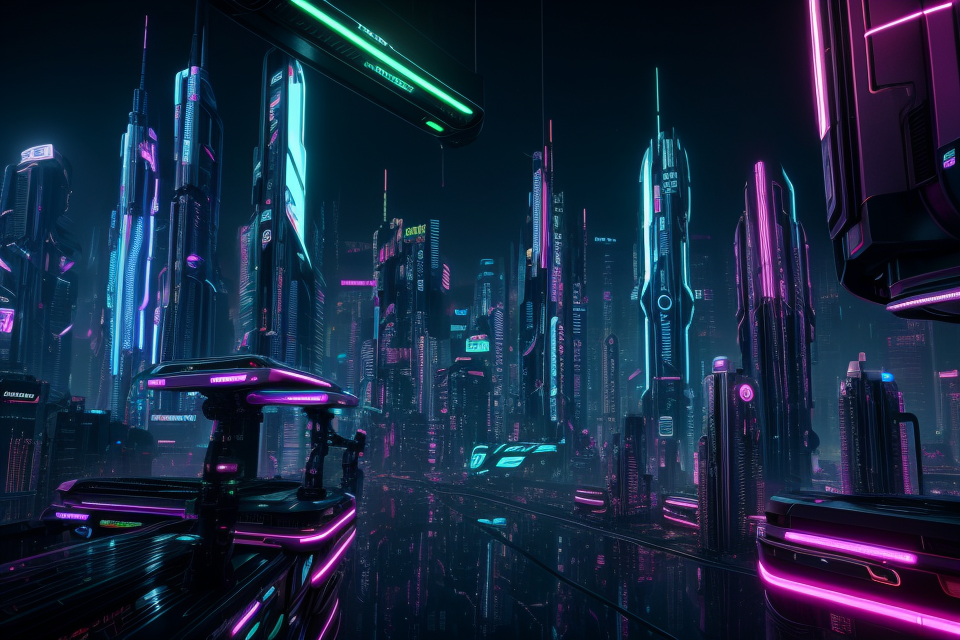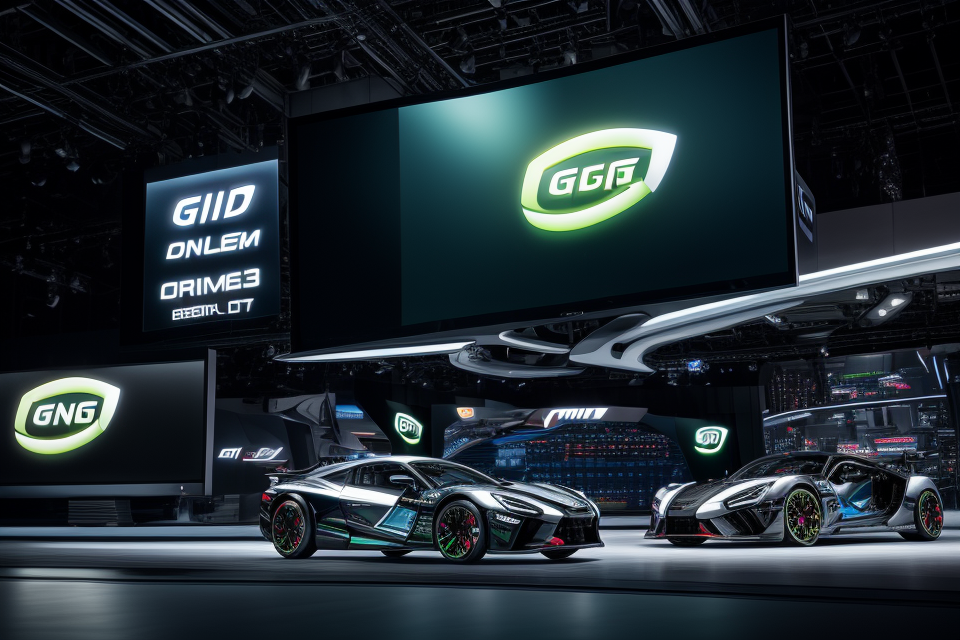
In today’s fast-paced world, where technology is constantly evolving, it’s no surprise that graphics cards have become an essential component of modern computing. These small yet powerful devices are responsible for rendering images and videos on our screens, and without them, our computers would be unable to handle even the most basic of tasks. In this article, we’ll explore the importance of graphics cards and why they’re crucial for modern computing. From gaming to graphic design, we’ll take a look at the various applications of graphics cards and how they help us achieve our goals more efficiently. So, let’s dive in and discover the world of graphics cards!
Understanding Graphics Cards: A Brief Overview
What is a graphics card?
A graphics card, also known as a display card or video card, is an essential component of a computer system that is responsible for rendering images and videos on the screen. It is designed to handle the complex calculations required to produce high-quality visuals in a wide range of applications, from simple text editing to sophisticated video games and 3D modeling.
At its core, a graphics card is a computer hardware component that connects to the motherboard of a computer and has its own memory and processing power. The primary function of a graphics card is to convert the data received from the CPU into a visual output that can be displayed on the screen.
In addition to its primary function, a graphics card also performs several other important tasks. For example, it can offload some of the processing workload from the CPU, freeing up resources for other tasks. It can also provide additional memory for the computer, which can improve performance in certain applications.
Overall, a graphics card is an essential component of a modern computer system, providing the necessary power and processing capabilities to enable high-quality visual output and smooth performance in a wide range of applications.
How graphics cards differ from integrated graphics
Integrated graphics, also known as onboard or shared graphics, are an integral part of a computer’s CPU. They share the same memory and resources as the CPU, which can limit their performance compared to dedicated graphics cards. In contrast, dedicated graphics cards have their own memory and processing power, which allows them to handle more demanding tasks and provide better performance.
Dedicated graphics cards are specifically designed for handling graphical tasks such as gaming, video editing, and 3D modeling. They have their own GPU (Graphics Processing Unit) which is designed to handle complex mathematical calculations required for rendering images and video. This allows them to provide better performance and faster frame rates compared to integrated graphics.
On the other hand, integrated graphics are suitable for basic tasks such as web browsing, document editing, and media playback. They are energy-efficient and can save power, making them ideal for laptops and other portable devices. However, they may not be able to handle demanding tasks such as gaming or video editing without slowing down the system.
Use cases and performance comparisons
The choice between integrated and dedicated graphics depends on the intended use of the computer. For casual users who only need their computer for basic tasks, integrated graphics may be sufficient. However, for users who require more demanding tasks such as gaming, video editing, or 3D modeling, a dedicated graphics card is essential.
In terms of performance, dedicated graphics cards offer better frame rates, higher resolutions, and smoother video playback compared to integrated graphics. Dedicated graphics cards also have more advanced features such as support for multiple displays, hardware acceleration, and more.
Overall, understanding the differences between integrated and dedicated graphics is crucial when choosing the right graphics card for your computer. It is important to consider your intended use and budget when making this decision.
The Evolution of Graphics Cards: A Timeline of Technological Advancements
Early graphics cards and their impact
In the early days of computing, graphics were simple and basic. The first computers did not have the capability to display images, and it was not until the late 1960s that the first graphics cards were introduced. These early graphics cards were primitive and could only display a few basic shapes and lines. However, they laid the foundation for the modern graphics cards that we know today.
The first graphics cards were developed by a company called General Instrument (GI). They were called “video display processors” and were used in early arcade games and some of the first home consoles. These graphics cards had limited capabilities, but they were a significant improvement over the standard text-based interfaces that were common at the time.
Despite their limitations, these early graphics cards had a profound impact on the development of computer graphics. They opened up new possibilities for game designers and other creative professionals, and they helped to popularize the use of personal computers for entertainment.
In the following years, graphics cards continued to evolve, with new technologies and capabilities being added with each passing year. Today, graphics cards are an essential component of modern computing, providing the power and performance needed to run the latest games, simulations, and other graphics-intensive applications.
GPU architectures and their influence on gaming and other applications
Graphics Processing Units (GPUs) have evolved significantly over the years, from simple 2D graphics acceleration to the complex 3D rendering and general-purpose computing capabilities that they offer today. These advancements have had a profound impact on the gaming industry and other applications that rely on high-performance graphics processing.
One of the most significant advancements in GPU architecture was the shift from 2D to 3D graphics acceleration. This shift enabled games and other applications to display three-dimensional graphics, providing a more immersive experience for users. 3D graphics required much more processing power than 2D graphics, which led to the development of more powerful GPUs.
The rise of programmable GPUs was another major advancement in GPU architecture. Programmable GPUs allow developers to write software that can be executed directly on the GPU, rather than on the CPU. This has had a significant impact on the performance and capabilities of GPUs. Programmable GPUs can perform complex calculations much faster than CPUs, making them ideal for tasks such as video encoding, scientific simulations, and of course, gaming.
The programmable GPU has also enabled the development of advanced rendering techniques, such as real-time ray tracing and global illumination. These techniques can create more realistic lighting and shadows in games and other applications, which has a significant impact on the overall visual quality.
Overall, the advancements in GPU architecture have had a profound impact on the gaming industry and other applications that rely on high-performance graphics processing. As GPUs continue to evolve, it is likely that they will play an even more critical role in driving the development of new technologies and applications.
The Impact of Graphics Cards on Gaming and Entertainment
Enhancing gaming experiences
Graphics cards play a crucial role in enhancing gaming experiences by providing smoother frame rates and reduced latency. This is achieved through the use of advanced hardware and software technologies that enable the graphics card to render images and video more efficiently. As a result, gamers can enjoy smoother, more seamless gameplay without any lag or delay.
In addition to smoother frame rates, graphics cards also enable realistic graphics and immersive environments. This is achieved through the use of advanced rendering techniques and high-resolution textures that create a more realistic and detailed gaming experience. As a result, gamers can become fully immersed in the game world, experiencing a heightened sense of realism and immersion.
Overall, the use of graphics cards is essential for modern gaming and entertainment. They provide the necessary hardware to render high-quality graphics and video, ensuring smooth and seamless gameplay. This allows gamers to fully immerse themselves in the game world, creating a more engaging and enjoyable gaming experience.
Advancements in VR and AR experiences
The advancements in virtual reality (VR) and augmented reality (AR) experiences have significantly revolutionized the way people interact with technology. These immersive technologies are transforming various industries, including gaming, education, healthcare, and more. Graphics cards play a crucial role in rendering the complex visuals required for VR and AR experiences, making them an essential component for modern computing.
- Dependent on graphics card performance:
- High-performance graphics cards are necessary for seamless VR and AR experiences. They enable realistic graphics and smooth frame rates, which reduce motion sickness and enhance immersion. The performance of graphics cards directly impacts the quality and fluency of VR and AR experiences.
- Potential applications and future developments:
- VR and AR technologies have a wide range of potential applications in various industries. For instance, in healthcare, VR and AR can be used for medical training, surgical planning, and pain management. In education, they can enhance learning experiences by providing interactive and immersive content. In the entertainment industry, VR and AR are transforming gaming, movies, and social experiences.
- Future developments in VR and AR are expected to bring even more advanced and realistic experiences. These may include increased integration with AI, improved sensory feedback, and greater interactivity. Graphics cards will continue to play a critical role in realizing these advancements, as they are essential for rendering the complex and dynamic visuals required for immersive experiences.
Overall, the impact of graphics cards on VR and AR experiences cannot be overstated. High-performance graphics cards are necessary for creating realistic and immersive experiences, and their importance will only continue to grow as VR and AR technologies advance.
Graphics Cards in Professional Applications: A Necessity for Innovation
Graphics cards in content creation and design
Graphics cards play a crucial role in content creation and design, as they provide the necessary processing power to handle demanding tasks such as video editing, 3D modeling, and animation.
In video editing, graphics cards can accelerate the rendering process, allowing editors to work with high-resolution footage and complex effects. They can also handle tasks such as real-time color correction, which would be too demanding for a CPU alone.
In 3D modeling and animation, graphics cards provide the necessary horsepower to render complex scenes and characters. This is especially important for industries such as film and gaming, where high-quality visuals are essential.
Graphics cards can also provide GPU acceleration for specific tasks, such as transcoding video or running simulations. This can greatly speed up the process and make these tasks more efficient.
Overall, graphics cards are essential for content creation and design, as they provide the necessary processing power to handle demanding tasks and allow professionals to work with high-quality visuals.
Scientific and research applications
Graphics cards are not only crucial for gaming and multimedia purposes but also play a significant role in scientific and research applications. These applications require high-performance computing and simulations, as well as data visualization and analysis.
- High-performance computing and simulations: Scientific research often involves running complex simulations and performing advanced calculations. These computations can be time-consuming and require significant processing power. Graphics cards, with their large number of cores and high clock speeds, are specifically designed to handle these types of tasks. They can accelerate simulations and calculations, reducing processing times and allowing researchers to analyze data more efficiently.
- Data visualization and analysis: Scientific research also involves visualizing and analyzing large amounts of data. Graphics cards are equipped with dedicated memory, known as VRAM, which allows them to handle large datasets. They can quickly render complex 3D models and visualizations, enabling researchers to gain insights from their data more effectively. Additionally, graphics cards often include features such as CUDA or OpenCL, which allow for optimized parallel processing, further enhancing their performance in data analysis tasks.
In summary, graphics cards are essential components in scientific and research applications due to their ability to handle high-performance computing, simulations, and data visualization requirements. Their advanced processing capabilities and dedicated memory make them indispensable tools for researchers in various fields, including physics, biology, and engineering.
The Future of Graphics Cards: Trends and Predictions
Continued advancements in GPU architectures
As technology continues to advance, so too do the capabilities of graphics cards. The future of GPUs is likely to bring even more impressive advancements, with a focus on artificial intelligence acceleration, deep learning, and real-time global illumination through ray tracing.
Artificial Intelligence Acceleration
One of the most exciting areas of development for graphics cards is their ability to accelerate artificial intelligence (AI) workloads. With the increasing demand for AI in fields such as healthcare, finance, and transportation, graphics cards are becoming essential tools for organizations looking to stay competitive. As AI algorithms become more complex, the need for powerful GPUs to run them will only continue to grow.
Deep Learning
Deep learning is another area where graphics cards are playing an increasingly important role. This technique involves training artificial neural networks to recognize patterns in data, which can be used for tasks such as image and speech recognition. With the rise of deep learning, demand for GPUs with high parallel processing capabilities has skyrocketed, as they are well-suited to the demands of deep learning workloads.
Real-Time Global Illumination through Ray Tracing
Finally, graphics cards are also expected to play a key role in enabling real-time global illumination through ray tracing. This technique involves simulating the behavior of light in a scene, allowing for more realistic and accurate rendering of light and shadows. While ray tracing has traditionally been too computationally intensive for real-time applications, advances in GPU architecture are making it possible to achieve real-time performance, opening up new possibilities for applications such as video games and virtual reality.
Overall, the future of graphics cards looks bright, with continued advancements in GPU architectures set to drive new innovations in AI, deep learning, and real-time global illumination. As these technologies continue to evolve, the importance of graphics cards will only continue to grow, making them an essential component of modern computing.
Emerging technologies and their impact on graphics cards
Graphics cards play a crucial role in the functioning of modern computers, and as technology continues to advance, the importance of these components is only set to increase. One of the key trends that is likely to shape the future of graphics cards is the rise of emerging technologies, such as virtual reality (VR) and augmented reality (AR), as well as quantum computing.
- Virtual Reality and Augmented Reality:
Virtual reality and augmented reality are technologies that are rapidly gaining popularity, and are expected to become increasingly mainstream in the coming years. These technologies require graphics cards to render highly realistic and immersive visuals, which can be achieved through the use of powerful GPUs. As VR and AR continue to evolve, the demand for graphics cards that can handle the increased workload is likely to increase, driving innovation and improvement in this area.
- Quantum Computing and its Potential Effects on Graphics Cards:
Quantum computing is a rapidly developing field that has the potential to revolutionize computing as we know it. While the technology is still in its early stages, it is expected to have a significant impact on graphics cards in the future. Quantum computing has the potential to greatly increase the processing power of computers, which could lead to the development of more advanced graphics cards that can handle even more complex tasks. This could lead to the creation of more realistic and immersive visuals, as well as the ability to handle larger and more complex datasets.
In conclusion, the future of graphics cards is likely to be shaped by emerging technologies such as VR, AR, and quantum computing. As these technologies continue to evolve, the demand for more powerful and advanced graphics cards is likely to increase, driving innovation and improvement in this area.
Addressing challenges and future developments
One of the primary challenges facing the development of graphics cards is the issue of power consumption and heat dissipation. As graphics cards become more powerful, they require more energy to operate, which can lead to higher temperatures and increased power consumption. To address this issue, manufacturers are exploring new technologies and materials to improve heat dissipation and reduce power consumption. For example, some graphics cards now feature liquid cooling systems, which can help keep temperatures under control and reduce the risk of overheating.
Another challenge facing the graphics card industry is the affordability and accessibility of high-performance graphics cards. With the increasing demand for graphics cards, prices have skyrocketed, making them difficult for many consumers to afford. This has led to a shortage of graphics cards on the market, with some models selling out almost as soon as they are released. To address this issue, manufacturers are exploring new production techniques and supply chain strategies to increase the availability of graphics cards and reduce their prices. Additionally, some companies are exploring alternative technologies, such as cloud gaming, which could reduce the need for high-performance graphics cards for some users.
Overall, the future of graphics cards is likely to be shaped by ongoing technological advancements and evolving consumer demands. As graphics cards continue to play an essential role in modern computing, addressing these challenges and future developments will be critical to ensuring that they remain accessible and affordable for all users.
FAQs
1. What is a graphics card and why is it necessary?
A graphics card, also known as a video card or display card, is a hardware component that is responsible for rendering images and videos on a computer screen. It is necessary because it offloads the graphics processing workload from the CPU, allowing it to perform other tasks more efficiently. Without a graphics card, the CPU would have to handle all the graphics processing, which would slow down the computer and cause it to be less responsive.
2. What are the benefits of having a good graphics card?
A good graphics card can provide several benefits, including faster rendering times, smoother video playback, and improved gaming performance. It can also enable higher resolutions and more advanced graphics effects, allowing for a more immersive visual experience. Additionally, a good graphics card can help support multiple displays, making it easier to work with multiple windows and applications at the same time.
3. How do I know if my computer needs an upgrade to a better graphics card?
If you are experiencing slow or choppy video playback, poor gaming performance, or other graphics-related issues, it may be time to upgrade your graphics card. Additionally, if you are working with software that requires intensive graphics processing, such as video editing or 3D modeling, a better graphics card can greatly improve your workflow. It’s also worth considering if you plan to upgrade your monitor or use multiple displays, as a better graphics card can support these features.
4. How do I choose the right graphics card for my computer?
Choosing the right graphics card for your computer depends on several factors, including your budget, the type of graphics processing you need, and the compatibility with your computer’s motherboard and power supply. It’s important to research different graphics cards and compare their specifications, such as the number of CUDA cores, memory size, and maximum resolution support. Additionally, you may want to consider the brand and reliability of the graphics card manufacturer.
5. Can I use a graphics card for both gaming and work?
Yes, many graphics cards are designed to be versatile and can handle both gaming and work-related tasks. Some graphics cards even have specialized features, such as support for virtual reality or advanced graphics processing, that can be useful for both gaming and work. However, it’s important to consider the specific requirements of your workflow and ensure that the graphics card you choose can handle the demands of your applications.


